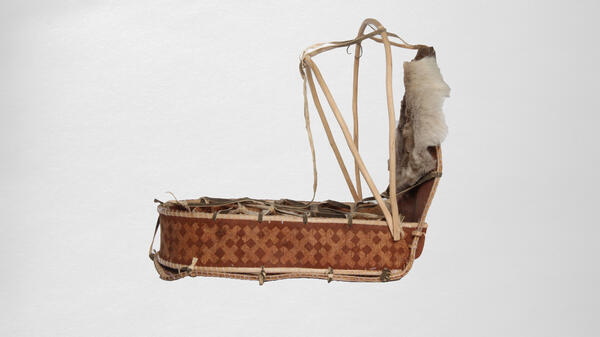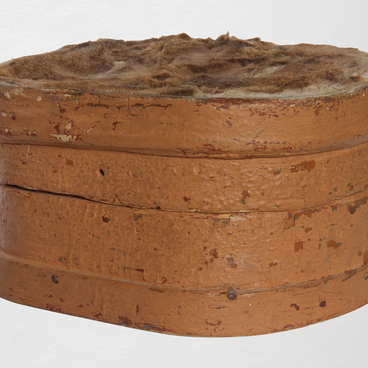When a child was born in a Khanty family, two permanent cribs were made — a night and a day one.
The night crib was an oval birch-bark box with low side panels, which tapered towards the feet. In such a crib, the child only slept.
The collection of the Muravlenko museum has a day cradle of the northern Khanty, made of birch bark. It has a semi-oval bottom and a high headboard, located almost at the right angle. A wooden rim holds the side panels together.
In such a crib, the child could sit and play. Unlike the night one, it could be hung from the upper poles of the tent with the help of a special hook. There were two types of day cribs: a heavier wooden one, typical for the eastern Khanty, and a light one made out of birch bark.
For cribs, the northern Khanty and Mansi chose brown birch bark. It was harvested in May or September, when it could be easily detached from the trunk. It was easier to apply an ornament on this birch bark: the upper brown layer was easily scraped off, and the yellow-orange inner surface created the necessary pattern. The Khanty decorated the outer side of the headboard and sides of the crib with drawings. The image of a wood grouse hen — the guardian of sleep — was obligatory. This ornament was placed on the outer surface of the headboard, opposite the child’s head. The Khanty believed that the wood grouse protected the baby’s sleep and made sure that his soul was resting.
The Khanty placed a birch bark mat inside the crib, on which they put crushed pieces of rotten wood, usually birch or pine wood. They absorbed moisture well. Deer neck hair or moss was laid on top of the pieces of rotten wood. When the pieces of rotten wood got wet, they were removed from the crib, but not thrown away, they were put in specially designated places.
The child spent almost all the time in the crib until he was three years old. To feed the baby, the mother put the bed on her lap, and when it was necessary to leave on business, she hung it by the loops from the tent pole or from the hook in the ceiling of the dwelling. It was also possible to sit and work next to the crib in this position, swinging it with a leg threaded through a loop.
If the family moved, then during walking, the crib was carried behind the back, the loops were connected on the chest. During a stop in the forest, it was hanged on by a tree high from the ground so that the child would not be disturbed by midges and a snake would not crawl to him. If they moved on reindeer, the mother took the crib in her sledge.
The night crib was an oval birch-bark box with low side panels, which tapered towards the feet. In such a crib, the child only slept.
The collection of the Muravlenko museum has a day cradle of the northern Khanty, made of birch bark. It has a semi-oval bottom and a high headboard, located almost at the right angle. A wooden rim holds the side panels together.
In such a crib, the child could sit and play. Unlike the night one, it could be hung from the upper poles of the tent with the help of a special hook. There were two types of day cribs: a heavier wooden one, typical for the eastern Khanty, and a light one made out of birch bark.
For cribs, the northern Khanty and Mansi chose brown birch bark. It was harvested in May or September, when it could be easily detached from the trunk. It was easier to apply an ornament on this birch bark: the upper brown layer was easily scraped off, and the yellow-orange inner surface created the necessary pattern. The Khanty decorated the outer side of the headboard and sides of the crib with drawings. The image of a wood grouse hen — the guardian of sleep — was obligatory. This ornament was placed on the outer surface of the headboard, opposite the child’s head. The Khanty believed that the wood grouse protected the baby’s sleep and made sure that his soul was resting.
The Khanty placed a birch bark mat inside the crib, on which they put crushed pieces of rotten wood, usually birch or pine wood. They absorbed moisture well. Deer neck hair or moss was laid on top of the pieces of rotten wood. When the pieces of rotten wood got wet, they were removed from the crib, but not thrown away, they were put in specially designated places.
The child spent almost all the time in the crib until he was three years old. To feed the baby, the mother put the bed on her lap, and when it was necessary to leave on business, she hung it by the loops from the tent pole or from the hook in the ceiling of the dwelling. It was also possible to sit and work next to the crib in this position, swinging it with a leg threaded through a loop.
If the family moved, then during walking, the crib was carried behind the back, the loops were connected on the chest. During a stop in the forest, it was hanged on by a tree high from the ground so that the child would not be disturbed by midges and a snake would not crawl to him. If they moved on reindeer, the mother took the crib in her sledge.



